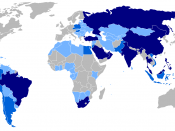Introduction
Golf tourism good or bad for developing countries?
Golf is now an incredibly popular sport. As a leisure activity, it is played and enjoyed by millions worldwide. As a profession, it enables talented players to earn a substantial amount of money from the game. Not just from prize money but also from the sponsorship and marketing opportunities. In a similar vein, Golfing holidays are an established part of the sport/activity tourism market, with countries such as Spain, Portugal, the Bahamas, Dubai, Singapore and Thailand all well-established destinations on the itinerary of golf tourism. Regardless of the obvious economic benefits to be gained by destinations aiming to take advantage of golf's popularity, there has been a steady flow of voices of concern about the impact of golf course developments, particularly in the less developed countries (LDCs) of the world (Palmer, 2005). This Review will examine some of the key issues and concerns raised, focusing specifically upon the LDCs as these countries are mainly dependent upon tourism as their main source of income.
In doing so, eight global internet sites were used with the majority being from 2000 - 2005.
The socio-economic consequences of golf tourism, particularly in the LDCs of the world, have not been heavily researched. King (2001) argues that golf resorts in Southeast Asia, targeted entirely at the needs and expectations of overseas visitors are often environmentally questionable because of the large amounts of water they consume. Golf courses require around 3000 cubic meters of water per day, which is enough to meet the needs of 15,000 local people. (AsiaGolf, 2002). Yet Water is a scarce resource for most LDCs and in the ordinary course of the day many local communities are forced to fetch their own water from lakes and reservoirs, while the tourist has...


